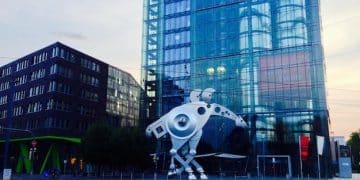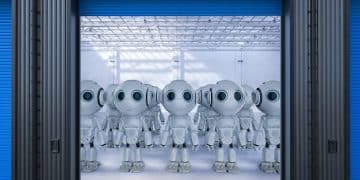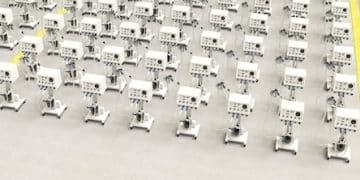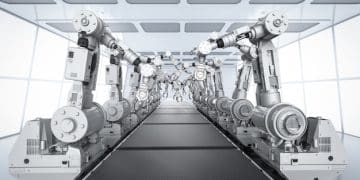Robotics Impact on US Manufacturing: Jobs Lost or Gained?

The integration of robotics into US manufacturing presents a complex dynamic, potentially leading to both job displacement in some areas and the creation of new, higher-skilled positions in others, ultimately reshaping the workforce rather than simply eliminating it.
The conversation surrounding The Impact of Robotics on US Manufacturing Jobs: Will Automation Lead to Job Losses or Gains? is far from simplistic. As technology advances at an unprecedented pace, the integration of robotic systems into the heart of American factories poses profound questions for the future of work. Understanding this complex interplay requires a nuanced look beyond mere headlines, delving into economic shifts, skill development, and policy adaptations.
The evolution of manufacturing: from mechanization to automation
Manufacturing has always been a crucible of innovation, constantly evolving to meet new demands and leverage emerging technologies. From the early days of simple machines powered by steam to the intricate assembly lines of the 20th century, each technological leap brought significant changes to production methods and the labor force.
The dawn of mechanization, characterized by devices assisting human labor, paved the way for mass production. This era saw the rise of factories and the specialization of tasks, leading to efficiency gains previously unimaginable. Worker roles shifted from artisanal craftsmanship to more repetitive, machine-assisted operations.
From mechanization to full automation
The transition toward automation marks a more profound transformation. Automation involves machines performing tasks with minimal or no human intervention, often through pre-programmed sequences or, increasingly, artificial intelligence. This shift has been driven by the pursuit of greater precision, increased speed, and reduced operational costs.
- Increased precision: Robots can perform tasks requiring extreme accuracy repeatedly without fatigue.
- Enhanced speed: Automated systems can operate much faster than human workers, boosting throughput.
- Cost reduction: While initial investment is high, long-term operational costs can decrease significantly due to lower labor expenditure and waste.
The current phase, marked by advanced robotics and AI, is not just about replacing manual labor but often about augmenting human capabilities and creating entirely new production paradigms. This evolution suggests that the relationship between humans and machines in manufacturing is becoming more collaborative than purely substitutive.
This historical trajectory illustrates that technological progress in manufacturing is a continuous process of adaptation and redefinition of work roles. Each stage has introduced both opportunities and challenges, pushing societies to innovate in education, training, and economic structures to accommodate the new realities.
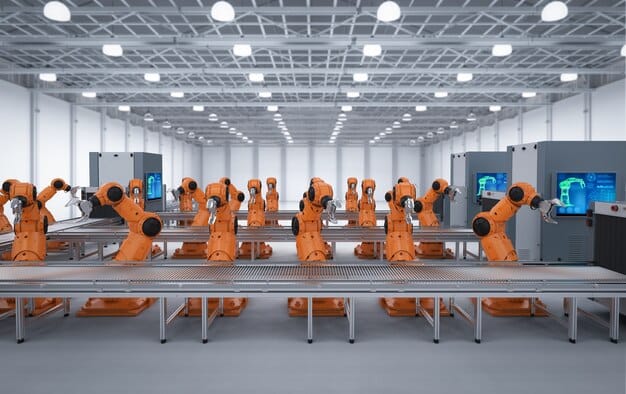
Robotics in motion: current adoption trends in US manufacturing
The adoption of robotics within US manufacturing is a dynamic and accelerating trend, driven by a confluence of economic pressures, technological advancements, and a renewed focus on domestic production. Understanding where and how these automated systems are being integrated provides critical insight into their immediate and future impact.
Industries as diverse as automotive, electronics, and food processing are at the forefront of this robotic surge. Robotics offer a means to enhance productivity, improve quality control, and address labor shortages in specific sectors. The precision and consistency of robotic operations minimize errors and waste, contributing to significant cost savings in the long run.
Key sectors embracing automation
The automotive industry has historically been a pioneer in robotic integration due to its high volume and repetitive assembly tasks. However, the scope of robotic application has broadened considerably.
- Automotive: Welding, painting, assembly, and material handling are heavily automated.
- Electronics: Micro-assembly, circuit board placement, and quality inspection benefit from robotic precision.
- Food & Beverage: Packaging, sorting, and even food preparation are increasingly automated to ensure hygiene and efficiency.
Small and medium-sized enterprises (SMEs), once seen as hesitant to invest in automation due to cost and complexity, are now also adopting robotic solutions. This shift is partly due to the emergence of more affordable, user-friendly, and adaptable robotic systems, including collaborative robots (cobots) that can work safely alongside humans.
The growing demand for customized products and shorter production cycles further propels robotic adoption. Robots can be reprogrammed quickly to switch between different tasks or product lines, offering flexibility that human labor often cannot match at scale. This agility is becoming a competitive necessity in a rapidly changing market.
Ultimately, the current trends indicate a widespread and deepening integration of robotics across the US manufacturing landscape. This is not a fleeting phenomenon but a fundamental transformation of production methods, influencing investment strategies and workforce planning across the nation.
The nuanced impact: job displacement versus job creation
The most pressing question regarding advanced robotics in manufacturing often revolves around employment: will robots systematically replace human workers, leading to widespread job losses, or will they create new opportunities that offset the displacement? The reality is more intricate than a simple dichotomy, suggesting a complex interplay of both phenomena.
It is undeniable that some jobs, particularly those involving highly repetitive, dangerous, or physically demanding tasks, are more susceptible to automation. Assembly line workers, machine operators, and material handlers may see their roles diminish or transform significantly as robots take over these functions. This can lead to localized job displacement in the short term, requiring adjustments for affected communities and individuals.
Emergence of new roles and skill sets
Simultaneously, the deployment of robots directly fosters the creation of new types of jobs. These emerging roles typically require different and often higher-level skill sets. Companies need individuals to design, program, install, maintain, and troubleshoot robotic systems. Data analysis, cybersecurity, and advanced engineering also become increasingly vital.
- Robotics engineers: Design and develop robotic systems.
- Maintenance technicians: Specialize in repairing and maintaining complex robotic machinery.
- Data analysts: Interpret data from automated processes to optimize efficiency.
- AI and machine learning specialists: Develop the intelligence behind autonomous systems.
Beyond these direct technical roles, automation can also lead to job growth in upstream and downstream industries. Increased manufacturing output due to robotics can stimulate demand for raw materials, logistics, and sales, thereby creating jobs in supporting sectors. The emphasis shifts from manual labor to supervisory, strategic, and creative roles.
The “job gain” aspect is often less visible than “job loss” because the new jobs are fundamentally different and require retraining. This necessitates a proactive approach to workforce development, with collaboration between industry, government, and educational institutions to equip workers with the skills needed for the automated future. The goal is not just to replace jobs but to elevate the human contribution within the manufacturing ecosystem.
Skill adaptation: bridging the gap for the future workforce
As robotics redefine the landscape of manufacturing, the skills required for the future workforce are undergoing a profound transformation. The traditional emphasis on manual dexterity and repetitive task execution is giving way to a demand for cognitive abilities, technical expertise, and adaptability. Bridging this skill gap is paramount for ensuring a smooth transition and maximizing the benefits of automation.
The future manufacturing worker will increasingly operate in concert with intelligent machines. This partnership necessitates a strong foundation in STEM (Science, Technology, Engineering, and Mathematics) fields. Understanding how robotic systems function, how to interact with their interfaces, and how to interpret their data output will be core competencies.
Essential skills for the new era
Beyond highly specialized robotic engineering, a broader array of skills becomes critical for front-line manufacturing employees.
- Robotics operation and monitoring: Safely operating and overseeing automated systems.
- Troubleshooting and diagnostics: Identifying and resolving issues within complex robotic cells.
- Data literacy: Interpreting performance metrics and process data.
- Problem-solving: Addressing unforeseen challenges in automated production environments.
- Critical thinking: Analyzing efficiencies and identifying areas for process improvement.
- Collaboration: Working effectively with both human and robotic counterparts.
The role of education, from vocational schools to universities, becomes central in preparing individuals for these new demands. Curriculum must evolve to include robotics, automation, and data science, moving beyond theoretical knowledge to hands-on practical application. Apprenticeship programs and industry-academia partnerships are vital conduits for practical skill transfer.
Furthermore, continuous learning and reskilling programs for the existing workforce are essential. Governments and companies have a shared responsibility to invest in lifelong learning initiatives, allowing workers whose roles are displaced to transition into new opportunities within the evolving manufacturing sector. This proactive approach to skill adaptation can transform potential job losses into strategic career shifts, ensuring a resilient and competitive workforce for the future.
Economic revitalization: how robotics can boost US manufacturing competitiveness
The discussion around robotics in manufacturing often gets narrowly framed by the immediate impact on jobs, but a broader perspective reveals their substantial potential for economic revitalization. By adopting advanced automation, US manufacturers can significantly enhance their global competitiveness, driving growth and creating long-term economic benefits that extend beyond the factory floor.
For decades, US manufacturing faced intense international competition, leading to offshoring and job migration. Robotics offer a powerful tool to reverse this trend. By increasing efficiency, reducing production costs, and improving product quality, automation allows domestic companies to compete more effectively even with high labor costs. This can lead to reshoring, bringing production back to the US.
Advantages of robotic integration for competitiveness
The strategic advantages of integrating robotics are manifold, creating a compelling case for investment.
- Increased productivity: Robots can operate 24/7 with consistent output, vastly increasing production capacity.
- Improved quality: Precision and repeatability minimize defects, leading to higher-quality products and reduced waste.
- Cost reduction: While initial investment is significant, long-term labor cost savings and efficiency gains lead to lower unit costs.
- Enhanced flexibility: Robots can be reprogrammed quickly to produce various products, adapting to market demand.
- Innovation acceleration: Automating routine tasks frees human talent to focus on research, development, and innovation.
Beyond these direct benefits, the revitalization of manufacturing sectors through robotics has ripple effects across the economy. It stimulates growth in technology development, software engineering, and a myriad of supporting services. A stronger manufacturing base can anchor regional economies, fostering a vibrant ecosystem of suppliers, researchers, and trained professionals.
Moreover, the adoption of advanced robotics can foster resilience in supply chains. By enabling more domestic production, it reduces reliance on overseas manufacturing, mitigating risks associated with global disruptions. This strategic advantage, combined with a focus on high-value, specialized production made possible by automation, positions US manufacturing for a robust and sustainable future in the global economy.
Policy and education: shaping a supportive ecosystem for automation
The transformative power of robotics in US manufacturing necessitates a proactive and integrated approach from policymakers and educators. Without a supportive ecosystem, the potential benefits of automation—economic revitalization and the creation of high-skilled jobs—may be undermined by challenges such as skill gaps, social displacement, and inequitable distribution of opportunities.
Government policies play a crucial role in shaping the environment for robotic adoption. This includes fostering research and development in robotics and AI, offering incentives for manufacturers to invest in automation (e.g., tax credits for R&D or capital expenditures), and establishing clear regulatory frameworks that promote safe and ethical deployment of these technologies.
Key areas for policy and educational focus
A multi-pronged approach is essential to maximize automation’s advantages while minimizing its downsides.
- Investment incentives: Tax breaks, grants, and subsidies to encourage businesses to invest in automation technology and research.
- Workforce retraining programs: Government-funded initiatives to reskill displaced workers and upskill the existing workforce for new roles in automated factories.
- STEM education enhancement: Increased funding and curriculum development for K-12 and higher education, focusing on robotics, coding, data science, and advanced manufacturing principles.
- Industry-academia partnerships: Encouraging collaboration between manufacturers and educational institutions to ensure training programs align with industry needs.
- Infrastructure development: Investment in digital infrastructure (e.g., 5G connectivity) essential for advanced automated systems.
Crucially, education systems must adapt swiftly. This means not just teaching specific technical skills but also fostering critical thinking, adaptability, and problem-solving—qualities that will remain invaluable amidst rapid technological change. Lifelong learning initiatives must become the norm, supported by accessible and affordable training opportunities.
Dialogue between government, industry, labor unions, and educational institutions is vital to anticipate future needs and develop cohesive strategies. By aligning policy frameworks with educational reform, the US can cultivate a workforce capable of thriving in an increasingly automated manufacturing landscape, ensuring that the benefits of robotics are broadly shared and contribute to national prosperity.
The long view: sustainability and ethical considerations
Beyond the immediate economic and employment impacts, the widespread adoption of robotics in US manufacturing prompts critical considerations regarding long-term sustainability and ethical implications. A truly beneficial integration of these technologies requires foresight and a commitment to responsible development, ensuring that automation serves societal well-being and not just industrial efficiency.
From an environmental perspective, increased automation can contribute to sustainability by optimizing resource use, reducing waste through precision manufacturing, and enabling localized production, thereby shortening supply chains. However, the energy consumption of robotic systems and the disposal of electronic waste also present challenges that need to be addressed through sustainable design and circular economy principles.
Ethical dimensions of automation
The ethical dimensions of robotics extend beyond job displacement to questions of fairness, accountability, and the nature of work itself.
- Fairness in job transitions: Ensuring equitable support and retraining for workers displaced by automation, preventing widening wealth disparities.
- Algorithmic bias: Avoiding embedded biases in AI-driven robotic systems that could lead to discriminatory outcomes in production or employment.
- Data privacy and security: Protecting sensitive operational and personal data collected by interconnected robotic systems.
- Human oversight and accountability: Defining clear lines of responsibility for errors or accidents involving autonomous systems.
- Worker well-being: Understanding the psychological impact of working alongside intelligent machines and designing work environments that foster human thriving.
Developing robust ethical guidelines and regulatory frameworks is crucial. These should involve multi-stakeholder dialogues, incorporating perspectives from industry, labor, academia, and civil society to create a shared understanding of responsible innovation. The goal is not to hinder progress but to ensure that technological advancements align with broader societal values.
Ultimately, the long-term sustainability of manufacturing in an automated future depends on a holistic approach that balances economic imperatives with environmental stewardship and social equity. By proactively addressing these ethical and sustainability considerations, the US can harness the full potential of robotics to build a more resilient, prosperous, and just industrial future.
| Key Point | Brief Description |
|---|---|
| 🤖 Job Transformation | Robotics displace some roles but create new, higher-skilled jobs in design, maintenance, and data analysis. |
| 📚 Skill Shift | Demand for STEM, problem-solving, and critical thinking skills paramount for the future manufacturing workforce. |
| 📈 Economic Boost | Automation enhances US manufacturing competitiveness, leading to reshoring, productivity gains, and innovation. |
| ⚖️ Ethical & Policy Needs | Proactive policies and education are vital to ensure ethical deployment, fair transitions, and broad societal benefits. |
Frequently Asked Questions About Robotics in Manufacturing
▼
No, robotics are unlikely to eliminate all manufacturing jobs. Instead, they are transforming the nature of work. While repetitive and dangerous tasks may be automated, new roles are emerging in robotics design, programming, maintenance, and data analysis. The human element will shift from manual labor to oversight, problem-solving, and strategic decision-making within automated environments.
▼
Automation significantly boosts the global competitiveness of US manufacturing by increasing efficiency, improving product quality, and reducing operational costs. Robots enable faster production cycles and consistent output, making it more feasible for companies to produce goods domestically rather than offshoring. This can lead to reshoring, strengthening the US industrial base against international competition.
▼
For an automated manufacturing environment, critical skills include robotics operation and monitoring, troubleshooting, data literacy, and critical thinking. Soft skills like problem-solving, adaptability, and collaboration are equally vital. Education and training programs are increasingly focusing on STEM subjects and hands-on experience with advanced machinery to prepare the workforce.
▼
Yes, smaller manufacturing companies are increasingly adopting robotics. The development of more affordable, user-friendly, and versatile robotic systems, particularly collaborative robots (cobots), has made automation accessible even for small and medium-sized enterprises (SMEs). These solutions help SMEs improve efficiency, reduce costs, and stay competitive without requiring massive upfront investments or highly specialized engineering teams.
▼
Ethical considerations with increased robotic automation include job displacement and the need for fair worker transitions, potential algorithmic biases in AI systems, and ensuring data privacy and security. Questions of human oversight, accountability for autonomous system errors, and the overall impact on worker well-being also need careful attention. Proactive policy and ethical guidelines are essential for responsible implementation.
Conclusion
The journey of robotics within US manufacturing is a testament to constant evolution, presenting a landscape of both challenge and immense opportunity. Far from a simple narrative of job destruction, the integration of automation is fundamentally reshaping the US industrial sector, demanding a workforce equipped with new skills, fostering enhanced competitiveness, and ultimately pointing towards an era of more efficient, precise, and resilient production. Navigating this transformation successfully hinges on a synergistic effort between policy, education, and industry, ensuring that the benefits of this technological revolution are widely distributed, leading to a stronger, more innovative, and ethically grounded future for American manufacturing.
